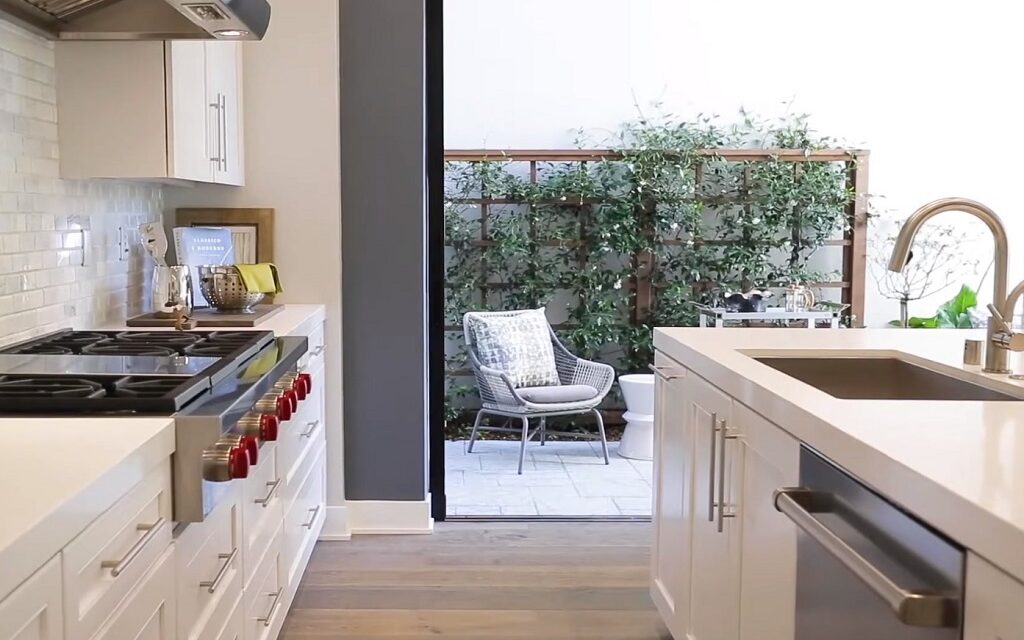When it comes to housing options, detached zero lot line homes have been gaining popularity in recent years. These unique single family properties offer a blend of urban living and suburban comfort, but like any housing choice, they come with their own unique set of advantages and limitations.
We became aware of detached zero lot line homes while recently touring several new housing communities in Southern California. Unbeknownst to us at the time, one of the single family home communities consists of properties that, in essence, share property lines. What caught our attention were patio areas that “touched” the exterior walls of a neighboring home. After inquiring, we learned that these new homes were classified as zero lot line properties, which are also referred to as “detached condos”.
Anyone searching for affordable housing options, or planning to downsize, or under the assumption that they can only afford a townhome or condominium will want to learn more about detached zero lot line homes.
In this article, we’ll delve into the pros and cons of detached zero lot line homes, exploring why they are becoming an attractive option for many homebuyers and what to know upfront if you are considering this type of home and community.
Table of Contents
- What’s a Detached Zero Lot Line Home?
- The Appeal of Detached Zero Lot Line Homes
- Advantages of Detached Zero Lot Line Homes
- Limitations of Detached Zero Lot Line Homes
- Example Detached Zero Lot Line Communities
- Conclusion
- FAQs
Also see:
- Top 10 Trending Amenities and Features of Luxury Condos
- Zombie Foreclosures: How to Find and Buy Abandoned Real Estate
- How to Profit from the Misfortunes of Opendoor & Other iBuyers
- Secrets to Finding an Undervalued Home for Sale
- More Recommended Home Buying Articles
- Related Topics: Home Buying | Mortgages | Real Estate | Proptech | Luxury Condos
What’s a Detached Zero Lot Line Home?
Detached zero lot line homes, often referred to as detached condos, patio homes or garden homes, are a type of housing where the structure is built very close to or directly on the property line, maximizing the use of available space. These homes typically have little to no yard on one or more sides, but often compensate with private courtyards, rooftop gardens, or shared green spaces.
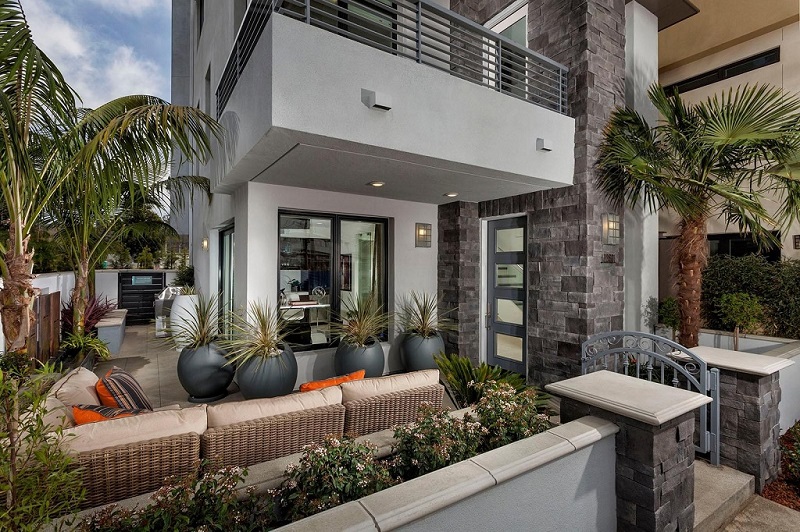
Front patio and entrance to a home in Asher at Play Vista
A detached zero lot line home will typically have one exterior wall that serves as the “dividing property fence” with a neighbor. In other words, one neighbor’s side area will run exactly to the surface of an adjacent neighbor’s side exterior wall.
It is also not uncommon for a detached zero lot line home to have one wall without windows to enhance the privacy of the adjacent neighbor. Signs of a poorly designed detached zero lot line homes, on the other hand, are two nearby walls that have windows that partially facing each other.
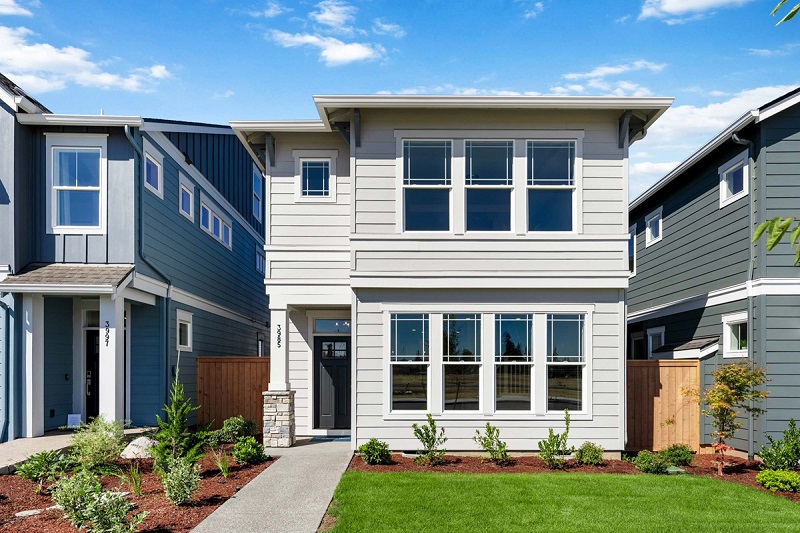
Front view of the Harrigan zero lot line model at Reed’s Crossing, Hillsboro, Oregon
Though townhomes, row houses and duplexes are also all classified as zero lot line homes, for the scope of this article, we are focusing on “detached zero lot line homes”, due to their rising popularity.
Given the legal complexities of “sharing property lines”, these communities are often managed by Homeowners Associations (HOAs) in similar fashion as condominium communities. There will likely be some kind of “shared common maintenance agreement” in place that defines shared responsibilities and policies for maintaining exterior elements between neighbors and an HOA.
The Appeal of Detached Zero Lot Line Homes
Urban Convenience with Suburban Comfort
Detached zero lot line homes typically strive to blend convenient city living with suburban comfort. Residents can enjoy the convenience of urban amenities (e.g. nearby shopping; public transportation; business centers; etc.) while having a more private and cozier space.
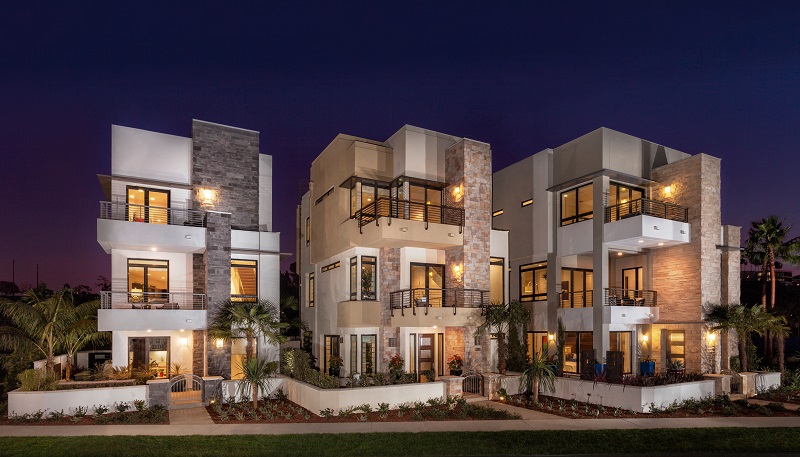
Model Homes of Asher at Playa Vista, San Pedro, California
Buyers of detached zero lot line properties may also be attracted by one or more of the following tradeoffs:
- Freeing up time by living in a more convenient location that costs more
- Living in a larger home in exchange for smaller, less private outdoor areas
- Downsizing from a larger property for an easier-to-maintain smaller property with convenient amenities
Low Maintenance
With limited outdoor space, these homes require less yard maintenance, making them ideal for busy professionals or those seeking a hassle-free living arrangement, such as recent retirees.
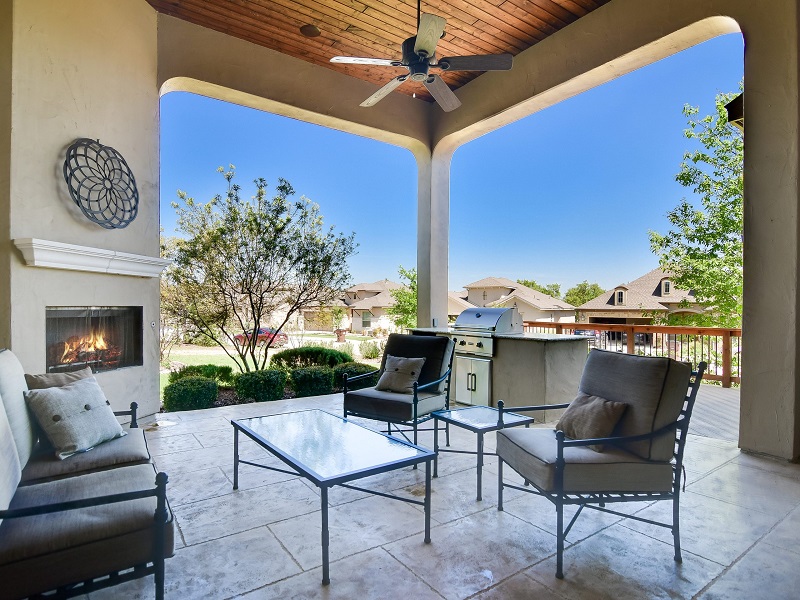
Covered back patio at Settler’s Ridge at Kinder Ranch, San Antonio, Texas
The umbrella term of “detached condos” is also instructive for understanding the maintenance benefits of detached zero lot line homes, as monthly HOA/condo fees are used to cover the on-going maintenance of common grounds and amenities (e.g. club house; walkways; pool; landscaping; etc.).
Community Benefits
Many detached zero lot line developments include modern shared amenities and spaces, fostering a friendly sense of community and neighborly interaction.

An outdoor community dining table at Reed’s Crossing, Hillsboro, Oregon
The extra amenities can serve as a valuable complement for homes with smaller square footage or reduced outdoor spaces, such as club houses with exercise equipment, party rooms with kitchens, and outdoor barbecue areas.
Economical Use of Land
Zero lot line construction allows developers to maximize land use in densely populated areas, contributing to efficient urban development with the goal of providing more affordable housing options in convenient areas where people desire to live.
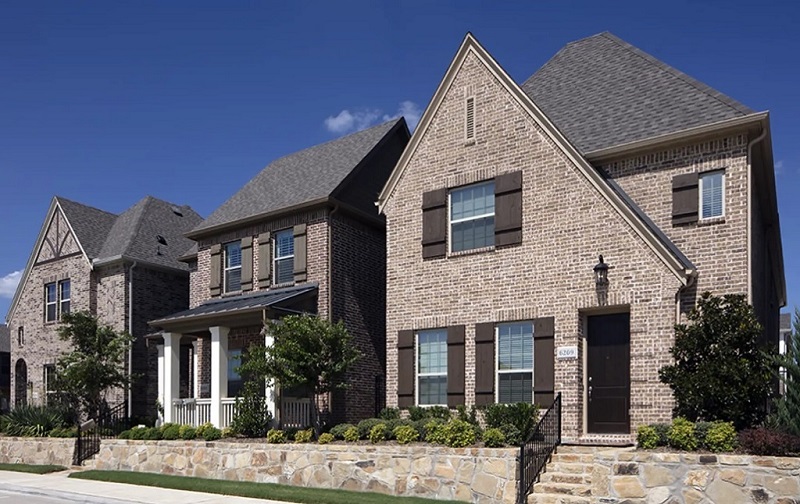
Section of Montgomery Farm Angel Field East 31s – Darling in Allen, Texas
Given this market need, we expect to see rising numbers of zero lot line home communities of all types for many years to come in costly real estate markets such as Southern California.
Also see:
Advantages of Detached Zero Lot Line Homes
Affordability
Detached zero lot line homes often come with a lower price tag compared to comparatively-sized single-family homes with similar amenities. Affordable pricing is likely the most important benefit of purchasing a detached zero lot line property.
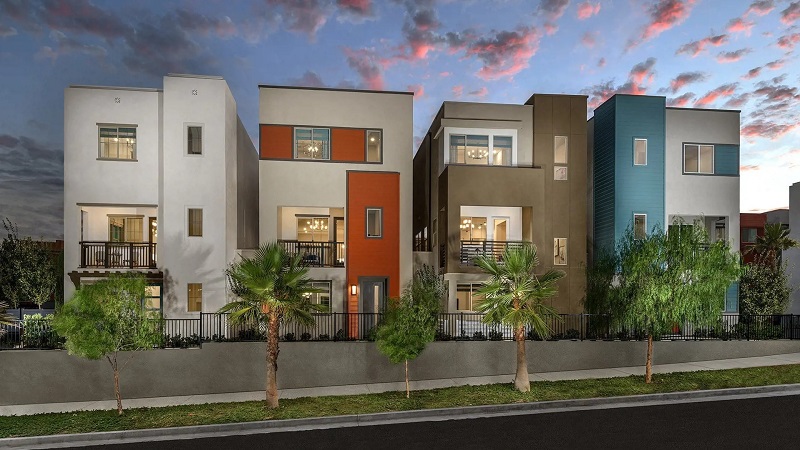
Section of Harbor Pointe at Ponte Vista, San Pedro, California
Affordability is primarily a result of sacrificing lot size and privacy in return for more interior square footage than could be afforded on a “standard” sized lot (a lot with a front, back and two side yards).
New zero lot line communities are especially striving to provide a stronger value proposition to prospective homebuyers by providing in-demand home features, community amenities, as well as passing along cost-savings by incorporating “more homes per acre” within a given development area.
Reduced Yard Maintenance
The lack of a traditional yard reduces the time and effort required for landscaping and maintenance, appealing to individuals with busy lifestyles or those who prefer minimal outdoor upkeep.
Increased Privacy
Though, in general, detached zero lot line homes offer less privacy than homes on standard lots, they certainly offer more privacy than other zero lot line property types, such as condominiums and townhomes.
While detached zero lot line homes are close to neighbors, they often include private outdoor spaces like patios or courtyards, providing a sense of seclusion for enhanced outdoor enjoyment.
New detached zero lot line development communities are making concerted efforts to increase privacy (both visual and auditory) with well-designed outdoor patio spaces, superior indoor sound insulation, and strategically placed windows.
Urban Proximity
Zero lot line homes are typically situated in urban or suburban areas with easy access to shopping, entertainment, and employment opportunities.
Homebuyers looking to reduce their commute times or purchase in historically high-priced urban areas should keep an eye on new home developments, as many are implementing detached zero lot line designs. Livabl is a convenient way to discover new home communities already selling or in early planning stages for your desired market
Community Atmosphere
Shared green spaces and common areas encourage a sense of community, fostering relationships among neighbors and creating a supportive living environment.

Community Green Space at Reed’s Crossing, Hillsboro, Oregon
The right suite of community amenities for a given homebuyer can also represent additional cost-savings and, perhaps more importantly, time-savings.
Limitations of Detached Zero Lot Line Homes
- Limited Outdoor Space
- Noise and Privacy Concerns
- Reduced Resale Value
- Limited Expansion Opportunities
- Homeowners Association (HOA) Rules
- Property Line Issues
Limited Outdoor Space
The main drawback of detached zero lot line homes is the lack of a traditional yard, which can be a downside for those who enjoy gardening, outdoor activities, or simply having more outdoor room.
This particular limitation, however, may actually be an attractive feature for some homebuyers, such as retirees downsizing to a home that is easier to maintain or families that require more indoor living space.
Also see:
Noise and Privacy Concerns
Due to the close proximity to other neighbors and to the street, residents of detached zero lot line homes might experience more noise and reduced privacy than those living in homes on standard single family lots. This limitation could be a concern for individuals seeking tranquility and a certain minimal level of privacy.
Though checking for adequate sound insulation is more challenging than checking for visual privacy, well-designed, contemporary detached zero lot line developments have been striving to meet these key needs of residents.
Also see:
Reduced Resale Value
The resale value of detached zero lot line homes, like all residential property types, will be influenced by a number of factors such as location, nearby amenities, recent comparable sales, and the overall real estate market. Any of these variables can lead to variability and uncertainty in investment returns.
Given that detached zero lot line homes are on smaller lots than comparably sized homes on standard lots, zero lot line homes should not, in theory, appreciate in value as fast. However, when compared to other types of zero lot line properites (e.g. condos, townhomes and duplexes), detached zero lot line homes should consistently appreciate faster due to having more square footage, outdoor areas and better privacy features overall.
A key variable that will impact resale value is the governing Homeowners Association (HOA) and associated fees and rules. A well-run HOA for a highly efficient and well-maintained community is critical to maintain a competitive resale value. Conversely, for example, a comparable single family community with standard lots could be at a disadvantage against a detached zero lot line community, if the standard lot community has an HOA with a poor reputation or a record of escalating fees and exhorbitant maintenance charges.
Limited Expansion Opportunities
Detached zero lot line homes often have limited potential for expansion, making it challenging to accommodate changing family n meeds or lifestyle shifts. However, similar expansion limitations will likely be encountered in other types of zero lot line properties and communities, as well.
One highly effective method of getting more usage out of existing square footage is to apply transformable design to key interior spaces for increased functionality.
Homeowners Association (HOA) Rules
Many zero lot line communities have HOAs that impose rules and restrictions, which might not align with everyone’s preferences or lifestyle choices.
In addition, it is imperative to research the transparency of the HOA to assess how efficiently it is managed, as well as the corresponding community (e.g. historical fees; overall condition of shared infrastructure; recurring maintenance fees; etc.).
Property Line Issues
Pertaining to key HOA rules, prospective homebuyers of a zero lot line home will need to understand upfront how property lines are managed, including: what is allowed; what is not allowed; what is the responsibility of the HOA; what is the responsibility of the homeowner; and how property line disputes are handled.
In particular, be sure to not take on any unnecessary liability, such as doing any maintenance work that is the responsibility of the HOA (e.g. painting an exterior wall that is deemed “common property”).
Also be sure to research your state’s “zero lot line” laws and homeowner rights. For example, Florida law grants homeowners of zero lot line properties access to four feet of a neighbor’s property in order to maintain a corresponding area of property.
Example Detached Zero Lot Line Communities
Here are a few links to new detached zero line housing communities to get familiar with community layouts, amenities and model floor plans:
- Cira Single-Family Homes at the Landing, Tustin, California
- Reed’s Crossing – The Villas Series, Hillsboro, Oregon
- Harbor Pointe at Ponte Vista, San Pedro, California
- El Sonido at Campanas, San Antonio, Texas
- Montgomery Farm Angel Field East 31s – Darling, Allen, Texas
- Messinger Village, Austin, Texas
- Settlers Ridge at Kinder Ranch, San Antonio, Texas
If you are considering a condominium or townhome, be sure to ask your realtor or search on line for zero lot line communities.
Mentioned previously in this article, Livabl is a website that lists new home developments of all kinds (e.g. luxury condominiums, townhomes, and single-family homes). It is possible, though not foolproof, to find some detached zero lot line communities on their site by selecting the following search criteria:
- Home Type: Single Family
- Ownership: Condo
Most likely lower comparative pricing with smaller lot sizes will be an indicator that a new community is offering zero lot line homes.
If you are searching for detached zero lot line homes on Zillow, we recommend individually testing the following search terms in the “Keywords” field listed at the bottom of the “More” search filter settings:
- “detached condo”
- “detached townhome”
Additionally, we have included below a few helpful videos that share examples of what it’s like owning a detached zero lot line home.
Walk-Through of a Zero Lot Line Home Owned by a Real Estate Couple in Frisco, Texas
Walk-Through of a Recently Landscaped Backyard of a Zero Lot Line in West Plano, Texas
Painting an Exterior Wall of a House on a Zero Lot Line
Conclusion
Detached zero lot line homes can offer unique living experiences that blend urban convenience with suburban charm. The decision to choose such a property depends on individual priorities and preferences. As with any housing choice, it’s important to weigh the pros and cons carefully before making a decision.
Homebuyers that are looking for a new home in a more costly urban area should certainly consider detached zero lot line communities to discover the latest in efficient home design and in-demand, on-trend community amenities.
FAQs
What are other names used to imply that a property is a “detached zero lot line home”?
Detached zero lot line homes are also referred to as:
- Single Family Zero Lot Line Homes
- Garden Homes
- Patio Homes
- Detached Condos
- Detached Townhomes
Keep in mind that “zero lot line” can also be used to describe townhomes, rowhouses, duplexes and even condominiums. For example, a townhome can be defined as an “attached zero lot line” property.
New zero lot line home developments are also referred to as “Z-lot developments“, while the term “zero lot line” can be referenced as ZLL.
Are detached zero lot line homes only found in urban areas?
No, while zero lot line properties of all kinds are more common in urban locations, detached zero lot line homes can also be found in suburban areas.
Can I still have a garden in a detached zero lot line home?
Yes, most detached zero lot line homes offer private outdoor spaces that can be landscaped to create small gardens or green areas.
Do detached zero lot line homes appreciate in value over time?
Like all real estate, appreciation can vary based on many variables, especially market conditions and location. However, in most comparable scenarios, detached zero lot line homes should appreciate faster on average than condominiums and townhomes.
Are there restrictions on home renovations in these communities?
Yes, many zero lot line communities have HOA rules that govern renovations and modifications to maintain a consistent aesthetic, as well as to protect against unauthorized alterations to common areas and features.
Are detached zero lot line homes suitable for families with children?
This depends on the family’s preferences and needs. Some families find the communal spaces and close-knit community appealing, while others might desire more space for children to play.
Though not solely pertaining to detached zero lot line home communities, new home communities of all types can be found that cater to young families, including the creation of new schools adjacent to the housing development.
More Recommended Home Buying Articles
- 8 Common Mistakes Made When Budgeting for a New Home
- 7 Questions to Ask Your Banker When Applying for a Home Loan
- Want the Best Mortgage Deal? Study APRs vs. Interest Rates!
- Proptech That Enables Homebuyers to Make All Cash Offers
- Green Mortgages: An Eco-Friendly Way to Combat Rising Interest Rates
- Want a Nontraditional House? Here’s How to Finance It!
- Real Estate Love Letters: Are They Legal?
- Options for Millennials Determined to Own a Home
- Enjoy Working Remotely? Here’s How to Choose to Live Wherever You Want
- Never Thought You’d Own Land? Think Again!
- Related Topics: Mortgages | Home Buying | Real Estate | Proptech
| Purgula is reader-supported. When you click on links to other sites from our website, we may earn affiliate commissions, at no cost to you. If you find our content to be helpful, this is an easy way for you to support our mission. Thanks! Learn more. |

